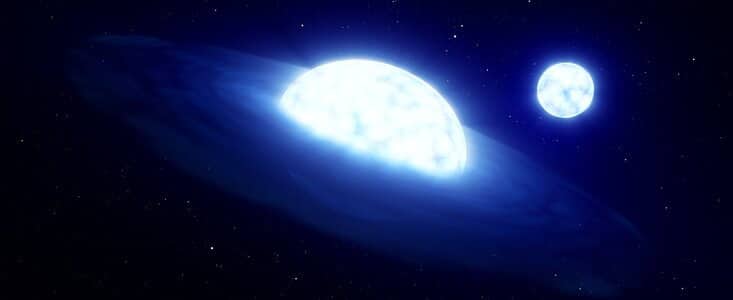In 2020, a team led by astronomers from the European Southern Observatory (ESO) reported the closest black hole to Earth, which is only 1000 light years away. But other researchers have disputed their results. After further observations from the ground and from space, both the original researchers and their critics came to the conclusion that there is no black hole

In 2020, a team led by astronomers from the European Southern Observatory (ESO) reported the closest black hole to Earth, located just 1000 light-years away in the system HR 6819. But other researchers disputed their results, including an international team from KU Leuven University in Belgium. In a paper published today, these two teams have come together to report that there is in fact no black hole in HR 6819, which is instead a two-star "vampire" system in a rare and brief stage of its evolution.
The original research on HR 6819 received a lot of attention from the press as well as scientists. Tomas Rivinius, an ESO astronomer based in Chile and the lead author of that paper, was not surprised by the reaction of the astronomical community to their black hole discovery. "Not only is it normal, it should also be, results should be checked carefully", he says, "and a result that deserves even more headlines".
Rivinius and his colleagues were convinced that the best explanation for the data they had, obtained with the MPG/ESO 2.20-meter telescope, was that HR 6819 was a triple system, with one star orbiting a black hole every 40 days and a second star in a much wider orbit. But research led by Julia Bodensteiner, then a PhD student at KU Leuven in Belgium, offered another explanation for those data: HR 6819 could also be a system with only two stars in a 40-day orbit and no black hole at all. This alternative scenario requires that one of the stars is "exposed", meaning that at an earlier time it lost a large part of its mass to the other star.
"We reached the limit of the available data, so we had to resort to a different observing strategy to decide between the two scenarios proposed by the two teams," said KU Leuven researcher Abigail Frost, who led the new study published today in the journal Astronomy & Astrophysics.
To solve the mystery, the teams worked together to obtain new, sharper data on HR 6819 using ESO's Very Large Telescope (VLT) and the VLT Interferometer (VLTI). "VLTI was the only tool that could give us the crucial data we needed to distinguish between the two explanations," says Dietrich Bade, who co-authored the original study on HR 6819 and the new paper in Astronomy & Astrophysics. Since there was no point in requesting the same observation twice, the two teams joined forces, and this allowed them to combine their resources and knowledge to discover the true nature of this system.
"The scenarios we were looking for were quite clear, very different and easy to distinguish with the appropriate device," says Rivinius. "We agreed that there are two light sources in the system, so the question was whether they surround each other closely, as in the exposed star scenario, or are they far from each other as in the black hole scenario."
To distinguish between the two proposals, the astronomers used the VLTI's GRAVITY instrument and also the MUSE instrument on ESO's VLT.
"MUSE confirmed that there is no bright companion star in a wider orbit, while GRAVITY's high spatial resolution was able to distinguish two bright sources that are only a third of the distance between Earth and the Sun," says Frost. "These data were the last part of the combination, and allowed us to conclude that HR 6819 is a binary system without a black hole."

2 תגובות
Jethro
Do you have a better theory?
I did not think….
"Black hole" = fake theory. Over time, it turns out that many "theories" do not hold true. Fabric stories of pseudo-scientists.